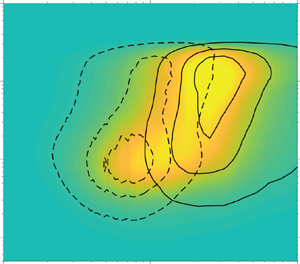Article contents
Decomposition of the mean friction drag on an NACA4412 airfoil under uniform blowing/suction
Published online by Cambridge University Press: 07 December 2021
Abstract

The application of drag-control strategies on canonical wall-bounded turbulence, such as periodic channel and zero- or adverse-pressure-gradient boundary layers, raises the question on how to distinguish consistently the origin of control effects under different reference conditions. We employ the RD identity (Renard & Deck, J. Fluid Mech., vol. 790, 2016, pp. 339–367) to decompose the mean friction drag and investigate the control effects of uniform blowing and suction applied to an NACA4412 airfoil at chord Reynolds numbers  $Re_c=200\,000$ and
$Re_c=200\,000$ and  $400\,000$. The connection of the drag reduction/increase by using blowing/suction with the turbulence statistics (including viscous dissipation, turbulence kinetic energy production and spatial growth of the flow) across the boundary layer, subjected to adverse or favourable pressure gradients, is examined. We found that the inner and outer peaks of the contributions associated with the friction-drag generation show good scaling with either inner or outer units, respectively. They are also independent of the Reynolds number, control scheme and intensity of the blowing/suction. The small- and large-scale structures are separated with an adaptive scale-decomposition method, namely the empirical mode decomposition (EMD), which aims to analyse the scale-specific contribution of turbulent motions to friction-drag generation. Results unveil that blowing on the suction side of the airfoil is able to enhance the contribution of large-scale motions and to suppress that of small scales; however, suction behaves contrarily. The contributions related to cross-scale interactions remain almost unchanged with different control strategies.
$400\,000$. The connection of the drag reduction/increase by using blowing/suction with the turbulence statistics (including viscous dissipation, turbulence kinetic energy production and spatial growth of the flow) across the boundary layer, subjected to adverse or favourable pressure gradients, is examined. We found that the inner and outer peaks of the contributions associated with the friction-drag generation show good scaling with either inner or outer units, respectively. They are also independent of the Reynolds number, control scheme and intensity of the blowing/suction. The small- and large-scale structures are separated with an adaptive scale-decomposition method, namely the empirical mode decomposition (EMD), which aims to analyse the scale-specific contribution of turbulent motions to friction-drag generation. Results unveil that blowing on the suction side of the airfoil is able to enhance the contribution of large-scale motions and to suppress that of small scales; however, suction behaves contrarily. The contributions related to cross-scale interactions remain almost unchanged with different control strategies.
JFM classification
- Type
- JFM Papers
- Information
- Copyright
- © The Author(s), 2021. Published by Cambridge University Press
References
REFERENCES
- 13
- Cited by





